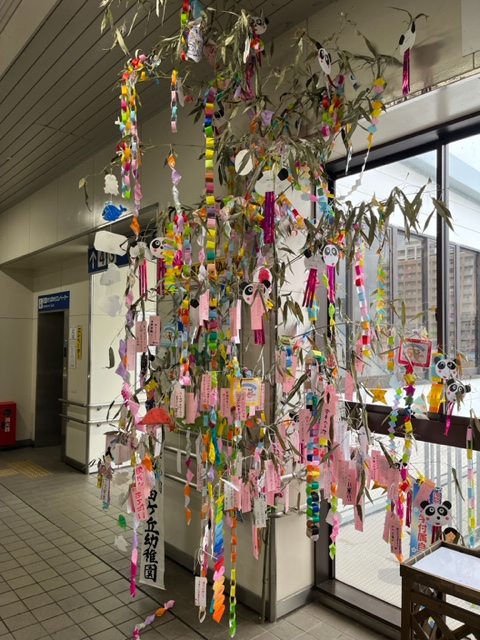
letters-home-tanabata-the-star-festival-and-the-nebuta-and-neputa-festivals
Every year, on July 7, Japan commemorates the Star Festival or “Tanabata” which celebrates the yearly meeting of two celestial lovers.
The festival has its origins in a 2000-year-old Chinese legend that features the meeting of two stars that are normally separated by the Milky Way, but are afforded an opportunity to meet once a year on the 7th day of the 7th lunar month — July 7.
Tanabata represents the romantic story of the two stars — Orihime, the beautiful and gifted princess of the sky king, represented by the Weaver Star (Vega); and Hikoboshi, the cow herder prince, better known as the Cowherd Star (Altair) — who are permitted to meet once a year if the skies are clear on this special day.
While the Tanabata Festival is celebrated all over Japan, to some degree, probably the most famous celebration in Japan takes place in Sendai, in northern Japan. The Sendai Festival in Miyagi Prefecture is a traditional event that has been commemorated for hundreds of years but is celebrated from August 6-8 instead of July 7.
The reason for this is that the Sendai celebration uses an old Chinese calendar which celebrated the festival a month later, and this tradition followed the custom of the old original festival, even though at some point the modern calendar became the norm, pushing it to July 7 for most of Japan.
The Sendai Tanabata Festival began during the Edo Period (1603-1868) and was popularized by the powerful samurai warlord, Lord Date Masamune when he wrote eight poems commemorating the Tanabata Festival. Large bamboo poles are decorated to celebrate the male and female stars. Many elementary schools celebrate this holiday by preparing an oversized sprig of bamboo to bring into the classroom, and then allowing the children to write their wishes on colored papers to tie onto its branches to decorate it (main photo).
Traditionally, wishes were embedded into seven specific types of decorations.
On colored paper cards, wishes for academic success and the hope to improve one’s calligraphy skills are infused into the “tanzaku” ornaments.
Little paper kimonos, called “kamigoromo” wish for healing and better sewing skills.
Small origami paper cranes, called “orizuru,” are made to wish for family safety and longevity.
Little paper purses are fashioned to symbolize prosperity in business and these are called “kinchaku.”
To wish for bountiful harvests and catches in fishing, little paper fishnets are made called “toami.”
“Kuzukago,” or tiny paper trashcans, are folded to represent cleanliness and frugality.
And finally, “fukinagashi” are miniscule paper windsocks that symbolize weaving and yarn, in order to wish for expert skills in weaving cloth.
Similar to Christmas decorations in the United States for Christmas trees, where families put all sorts of meaningful ornaments and decorations on their trees, I honestly don’t think there are any hard or fast rules concerning what types of decorations can be made and included on the bamboo tree limbs during Tanabata.
During all the years I have been in Japan, I have seen some very creative and interesting renditions of the traditional decorations made by school kids to decorate their Tanabata displays. The most common, by far, are the “tanzaku” papers where people write their wishes and hang them on the bamboo branches in hopes that their wishes will be realized and come true. As examples of typical wishes, normally students wish for academic success, while parents wish for the good health of their children.
Tanabata is a typical festival in that because it occurs in the summer, it comes with delicious street-food stalls that people enjoy sampling. These foods are not only eaten at festivals, but year-round throughout all of Japan, but especially during the summer festival events.
Takoyaki is made of fried dough balls that have a bit of octopus inside. A favorite street stall food, these are a popular treat for families all over Japan. There are chain restaurants that specialize in takoyaki because it is so popular.
Yakisoba is a dish consisting of cooked noodles and cabbage with pork, and is often prepared on a large, flat grill. It is a favorite dish prepared when camping, too. It is flavored with mayonnaise and a soy-based sauce.
Okonomiyaki is a thick pancake-like dish that has a variety of ingredients cooked inside it and then covered in sauce. Yakitori is grilled chicken on a skewer dipped in sauces, often served with onions between the chicken pieces, like a shish kebob. Yakitori shops are plentiful all over Japan and are a favorite of not only Japanese people, but also of visitors from overseas.
Processions are a large part of most summer festivals in Japan, and Tanabata is no different. People gather, wearing their summer cotton yukatas and join in planned festivities like dancing and chanting. Often fireworks are set off at night and attendees enjoy perusing the street stalls and the fun atmosphere of the festivals.
I lived in Aomori Prefecture for 20 years and it hosts one of the largest and most famous summer festivals in Japan, called Nebuta. It is held every year from August 2-7 and features huge painted floats that are lit up from the inside. They are enormous in size and made out of painted washi paper that is stretched over a wire frame. Some of the more elaborate ones take a year to construct and paint.
The floats can be nine meters wide, seven meters deep, and five meters high, which take up the entire street width as they are pushed by teams of revelers; they are accompanied by troupes of taiko drummers and traditional flutists. The floats represent human figures depicting historical characters, warlords, and even kabuki characters (photo).
The first time I attended the Nebuta Festival, I had just arrived in Japan in 1989 on the Japan Exchange and Teaching (JET) Program. All of us new teachers were feted to this wonderous experience of dance, music, foods, and floats while jumping around on one foot chanting Rasera-Rasera. Needless to say, it was unlike anything I had ever experienced in Indiana and I found it all to be quite enjoyable and fascinating.
Since I lived there for 20 years, I had many opportunities to attend this festival along with a similar festival in Hirosaki called Neputa. The Hirosaki festival features large, meticulously painted fan-shaped floats (photo) that depict scenes and images of warriors, as well, but it is a more subdued festival and the floats aren’t as menacing looking.
I was told by the locals in Hirosaki that the festival’s origin is related to “nemuri nagashi” which is a traditional event to expel the pesky and persistent sleep demon that afflicts people during harvest time to make them sleepy and less productive. This festival is an attempt to cast that sleep demon away so the people can get on with the task of bringing in the rice and apple harvests.
Whatever the reason for the festival originally, today it continues to be an incredible sight to behold and quite grand and exciting to experience. Both the Nebuta and Neputa Festivals in Aomori Prefecture are must do activities if you find yourself in the area in early August.
Get the most recent Shelby County Post headlines delivered to your email. Go to shelbycountypost.com and click on the free daily email signup link at the top of the page.





